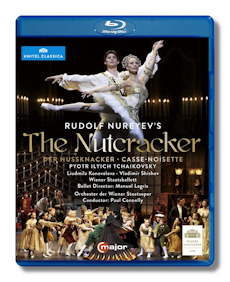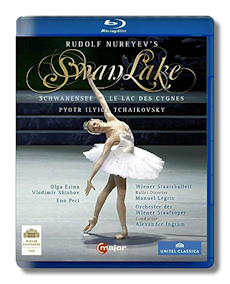
The Internet's Premier Classical Music Source
Related Links
- Tchaikovsky Reviews
- Latest Reviews
- More Reviews
-
By Composer
-
Collections
DVD & Blu-ray
Books
Concert Reviews
Articles/Interviews
Software
Audio
Search Amazon
Recommended Links
Site News
 Blu-ray Review
Blu-ray Review
Piotr Ilyitch Tchaikovsky

The Nutcracker
- Liudmilla Konovalova - Clara
- Vladimir Shishov - Drosselmeyer/The Prince
Artists of the Vienna State Ballet
Orchestra of the Vienna State Opera/Paul Connelly
Choreography by Rudolf Nureyev
Filmed live at the Vienna State Opera, 7 October 2012
Unitel Classica/C Major Blu-ray 718304 102m LPCM Stereo DTS-HD Master Audio
Also available on DVD 718208:
Amazon
- UK
- Germany
- Canada
- France
- Japan
- ArkivMusic
- JPC


Swan Lake
- Olage Esina - Odette/Odile
- Vladimir Shishov - Prince Siegfried
- Eno Peci - Rothbart, the Magician
Artists of the Vienna State Ballet
Orchestra of the Vienna State Opera/Alexander Ingram
Choreography by Rudolf Nureyev after Marius Petipa & Lev Ivanov
Filmed live at the Vienna State Opera, 16 March 2014
Unitel Classica/C Major Blu-ray 717704 132m LPCM Stereo DTS-HD Master Audio
Also available on DVD 717608:
Amazon
- UK
- Germany
- Canada
- France
- Japan
- ArkivMusic
- JPC
C Major released two Tchaikovsky bonbons straight from Vienna – The Nutcracker and Swan Lake. As the main classical ballet company in Austria, the Vienna State Ballet (Wiener Staatsballett) isn't particularly over-represented on home video, so these recent performances filmed live in high-definition at the Vienna State Opera are definitely welcome. The driving force behind these releases is without doubt former Paris Opera Ballet étoile Manuel Legris, who is leading the Viennese company since 2010 and has by all accounts established himself as a blessed gift for the thus far slumbering Austrian troupe.
Both ballets, choreographed by Rudolf Nureyev (after Marius Petipa and Lev Ivanov), are appropriately large-scaled, spectacular productions, cast in a classical yet at the same time highly personal mold. Legris's own career took shape under the wings of Nureyev while he was at the helm of the Paris Opera Ballet in the 1980's. As most dancers of the so-called Nureyev generation, Legris quite naturally shares a profound admiration for the legacy of the legendary Russian superstar, and the results can be seen here. Swan Lake was already in the repertory of the Vienna State Ballet since Nureyev himself staged it there in 1964, yet it was fittingly revamped for its 50th anniversary revival with attractive new sets and costumes. The Nutcracker on the other hand was a premiere for Vienna which Legris brought in from Paris in 2012.
Although it has become customary to disparage Nureyev's transcriptions of the great classics (and to tell the truth there is a lot to be said against them, not in the least the choreographer's tendency to squeeze in as many difficult steps and combinations as possible, but then again if somebody knows of a Nutcracker or a Swan Lake that looks ideal on all fronts, I'd be delighted to hear so), they do stand the test of time quite well because of their theatrical vitality and complete faith in dance.
In Swan Lake Nureyev characteristically enhanced the principal male role, turning the Prince instead of the Swan into the central character of the story – an idea he found in Western productions of the time and was eager to develop later on. To his credit he also believed with Tchaikovsky that Swan Lake doesn't have a happy ending. Yet for the most part, as is customary in this ballet with its twisted performance history, the score has been treated very liberally and plenty of music is used for other purposes than it was originally composed. For example the music of the Pas de trois in Act I is abandoned altogether and replaced with parts of the Pas de six from Act III; the music commonly used for the Black Swan pas de deux is danced here to the extra numbers Tchaikovsky wrote at the request of a ballerina after he completed his score in 1877. However, most important of all, even with these personal accents and modifications, Nureyev kept Swan Lake essentially as a timeless lyric tragedy expressed in dance. The lakeside scenes remain traditional and are especially well staged with the new designs from Luisa Spinatelli adding to their visual splendor and poetry.
With his Nutcracker Nureyev continued the Soviet-Russian tradition which focuses the plot on a single character, the young girl Clara, and eliminates the Sugar Plum Fairy as well as a lot of the magic. Clara is danced here by the same adult ballerina all the way through. Nureyev added one of his favorite topics – the dream – and presented the whole narrative after the party as a reflection of the subconscious. It's not the most comfortable of dreams though as it seems to dig deep into the psyche of the girl. At one point Clara sees family members and guests as menacing rats and bats and the handsome prince she falls in love with is none else than her godfather Drosselmeyer. You won't find candy and fairytale wisdom in this much darker setting, even it still allows for the familiar Nutcracker scenes, including the Christmas party, cavorting children, snowflakes and a winter pine forest, and colorful exotic dances in Act II. No radical rearrangements of the score here, just a few cuts and a reprise of Act I music at the closing pages of the ballet.
The Vienna State Ballet may as yet not give such a rounded impression as some of the more famous companies, but nonetheless these performances are enlivened by a sense of discovery and purpose, proving the artists not only relish the opportunities of drama and dance to the hilt, but also tackle the challenges with notable gusto. The ballerinas Olga Esina as Odette-Odile and Ludmilla Konovalova as Clara are equally magnificent in their roles. Vladimir Shishov who is their prince in both ballets is an attractive personality, but anybody who has seen Nureyev himself in the very same production of Swan Lake (as it was preserved in a famous film with Margot Fonteyn from 1966), knows there is a lot more to the dancing than Shishov is able to give.
Tchaikovsky sounds very well with the Vienna State Opera Orchestra and both Paul Connelly and Alexander Ingram conduct with exemplary balletic flair.
Michael Beyer directed the films in a traditional manner. We even get the wide-eyed kids in the theatre during the Overture of The Nutcracker and romantic swans-in-a-pond images at the beginning of Swan Lake. Unlike many opera and ballet films there are absolutely no shots of the musicians in the orchestra pit. Editing is generally agreeable; even if there are a few moments you wished they hadn't shot the dancers from the waist up that long (as in The Nutcracker pas de deux).
The sound quality is excellent on these releases, perhaps with a slightly more natural and better balanced sound on the more recent Swan Lake. (The lower brass is very prominent during tutti in The Nutcracker, although this might be partly maestro Connelly's doing.) The DTS-HD MA 5.0 mix is very impressive, offering a faithful reproduction of the actual orchestra's placement in the pit, with the violins divided and the celli and basses forming a rock-solid base in the middle.
Both releases also offer brilliant visuals. The HD transfers are amazingly sharp from every camera distance and show rich colors and incredible details on faces and the lavish costumes. My only quibble is the over-exposed and blue-saturated swan groups in the lakeside scenes. Surely the much subtler lighting of the actual theatre experience could have been reproduced with more accuracy.
A much more serious flaw, however, are the stage noises. Somebody must have forgotten they were recording a ballet, as in some quieter passages of The Nutcracker thumping feet are virtually drowning the music. While stage noises are unavoidable they are never this overwhelming in a live performances even with a dance ensemble of 30 or more on stage. Kids are running about a lot during the party, but also the corps de ballet dancers in the Waltz of the Snowflakes hitting the stage after a leap sound like gunshots. The problem is thankfully less distracting, though still somewhat present, in the more recently filmed Swan Lake.
Neither of the Blu-ray discs contains any bonus features. The main menu to select chapters or audio format (set on PCM Stereo by default) can only be accessed after the disc started playing, which is unpractical.
In short, the Viennese Swan Lake is well worth having, even if you already own (an)other version(s) of this ever-fascinating ballet. Unfortunately I cannot give the same wholehearted recommendation to The Nutcracker because of the sound issue which should have been avoided. If you can live with it though, you are set for a couple of enjoyable ballet evenings at home.
Copyright © 2015, Marc Haegeman




















